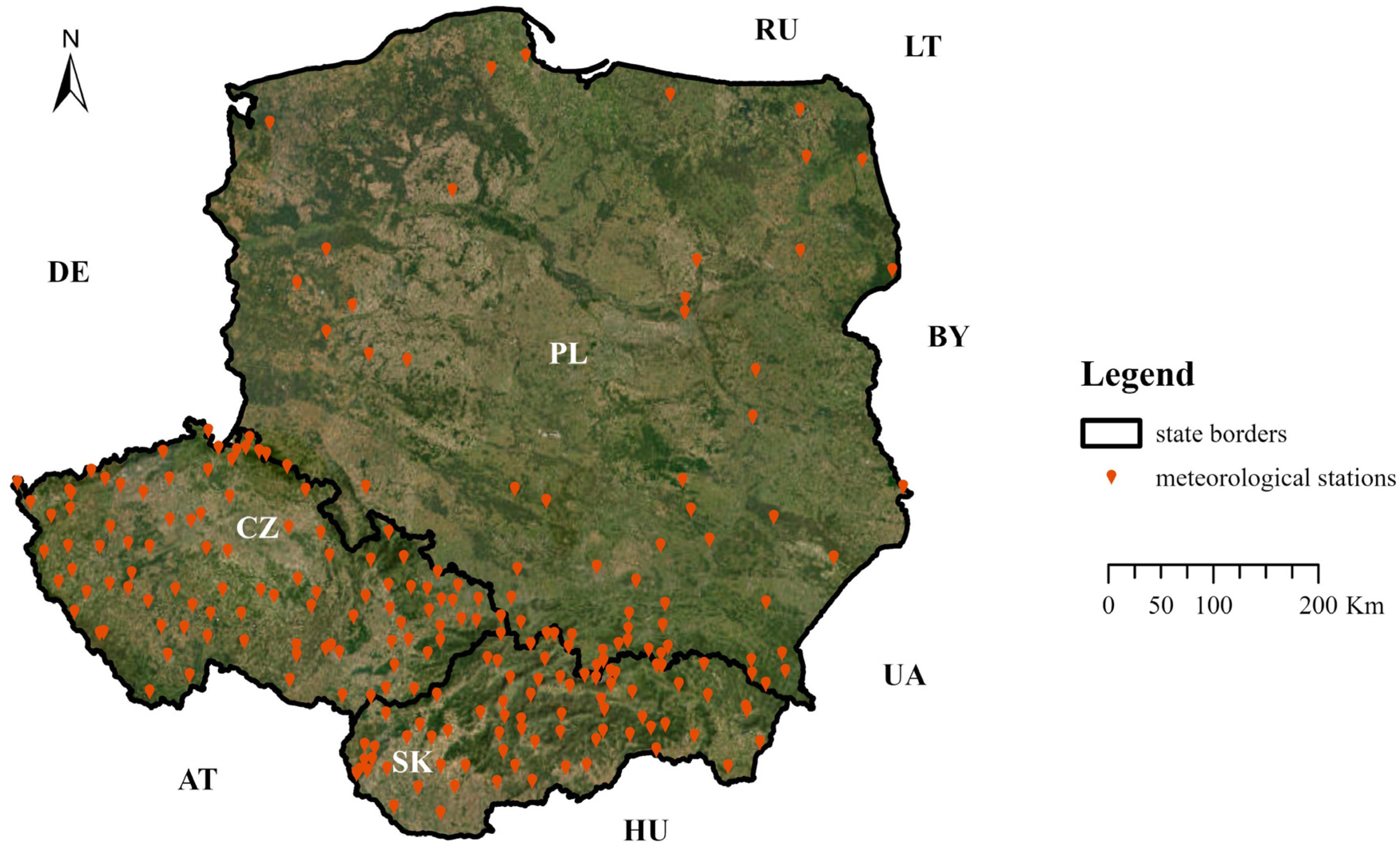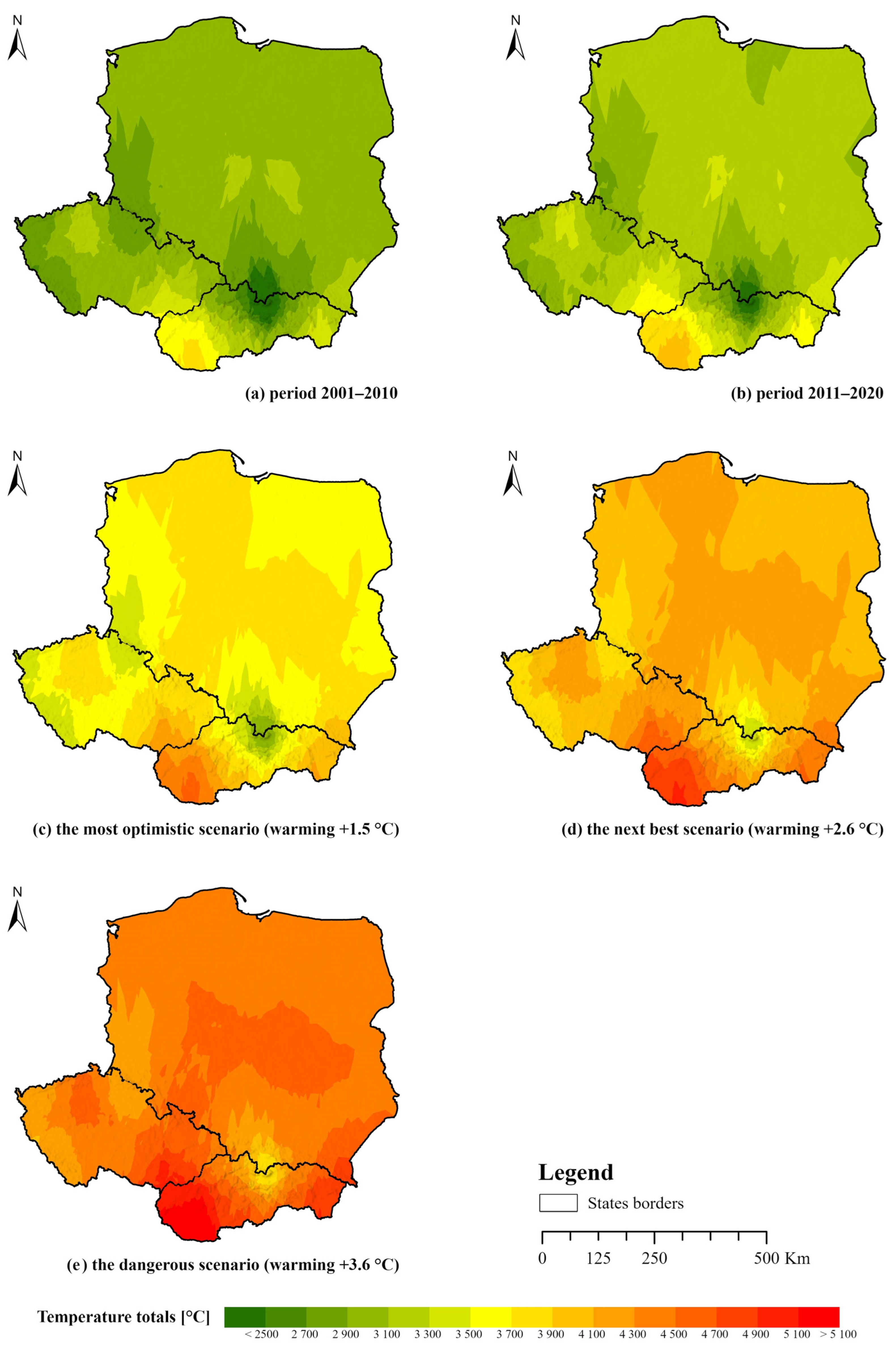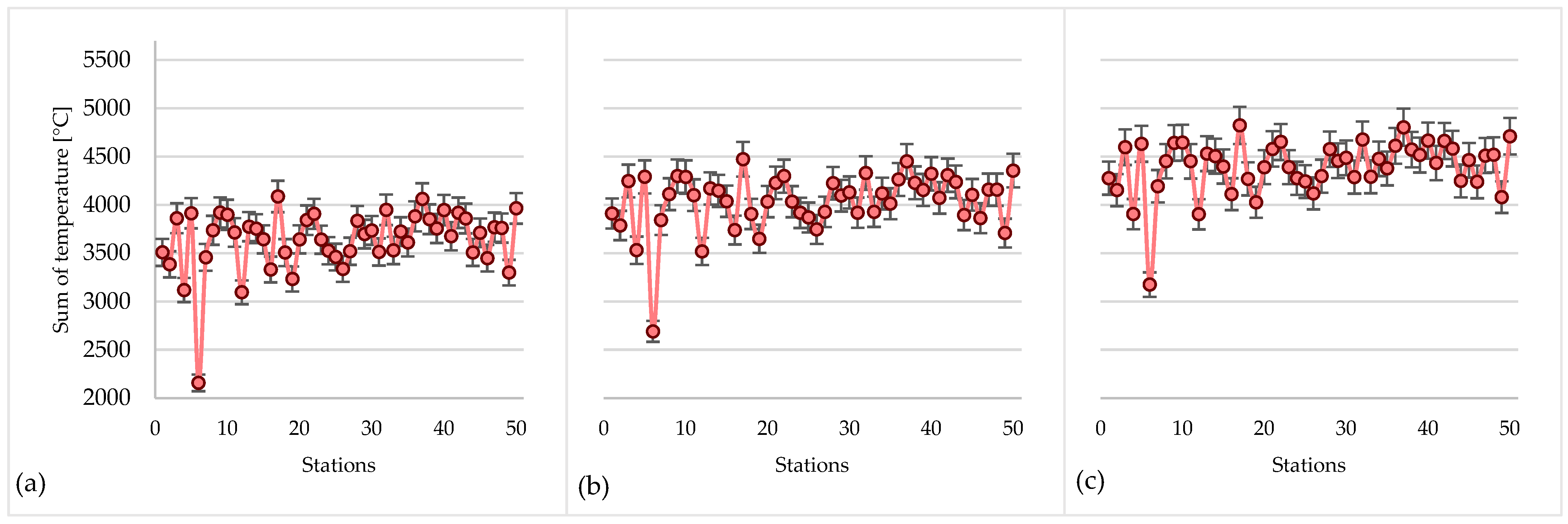From Optimism to Risk: The Impact of Climate Change on Temperature Sums in Central Europe
Abstract
1. Introduction
2. Materials and Methods
2.1. Study Area
2.2. Data Analysis
- onset of temperatures:
- termination of temperatures:
2.3. Map Processing
3. Results
3.1. Temperature Sums
3.1.1. The First Decade of the 21st Century 2001–2010
3.1.2. The Second Decade of the 21st Century 2011–2020
3.1.3. The Most Optimistic Scenario (Warming + 1.5 °C)
3.1.4. The Next Best Scenario (Warming + 2.6 °C)
3.1.5. The Dangerous Scenario (Warming + 3.6 °C)
3.2. Percentage Error
4. Discussion
5. Conclusions
Author Contributions
Funding
Data Availability Statement
Acknowledgments
Conflicts of Interest
References
- NOAA. Climate Change Impacts. Available online: https://www.noaa.gov/education/resource-collections/climate/climate-change-impacts (accessed on 4 November 2024).
- Copernicus. New Record Daily Global Average Temperature Reached in July 2024. Available online: https://climate.copernicus.eu/new-record-daily-global-average-temperature-reached-july-2024 (accessed on 4 November 2024).
- WMO. 2024 is on Track to Be Hottest Year on Record as Warming Temporarily Hits 1.5 °C. Available online: https://public.wmo.int/news/media-centre/2024-track-be-hottest-year-record-warming-temporarily-hits-15degc (accessed on 4 November 2024).
- WMO. Global Temperature Is Likely to Exceed 1.5 °C Above Pre-Industrial Level Temporarily in Next 5 Years. Available online: https://public.wmo.int/news/media-centre/global-temperature-likely-exceed-15degc-above-pre-industrial-level-temporarily-next-5-years (accessed on 4 November 2024).
- Labudová, L. Najnovšia Správa WMO [The Latest WMO Report]. 2024. (In Slovak). Available online: https://www.shmu.sk/sk/?page=2049&id=1486 (accessed on 4 November 2024).
- European Parliament. Climate Change in Europe: Facts and Figures. Available online: https://www.europarl.europa.eu/topics/en/article/20180703STO07123/climate-change-in-europe-facts-and-figures (accessed on 6 November 2024).
- Markovič, L.; Pecho, J. Teplota Vzduchu Rastie v Európe viac ako Dvojnásobným Tempom v Porovnaní s Globálnym Priemerom [Air Temperatures in Europe Are Rising at More Than Twice the Global Average]. Available online: https://www.shmu.sk/sk/?page=2049&id=1278 (accessed on 4 November 2024). (In Slovak).
- EEA. Global and European Temperatures. Available online: https://www.eea.europa.eu/en/analysis/indicators/global-and-european-temperatures (accessed on 4 November 2024).
- European Commission. Tackling Climate Change. Available online: https://agriculture.ec.europa.eu/sustainability/environmental-sustainability/climate-change_en (accessed on 6 November 2024).
- Yuan, X.; Li, S.; Chen, J.; Yu, H.; Yang, T.; Wang, C.; Huang, S.; Chen, H.; Ao, X. Impacts of Global Climate Change on Agricultural Production: A Comprehensive Review. Agronomy 2024, 14, 1360. [Google Scholar] [CrossRef]
- Sobocká, J.; Šurina, B.; Torma, S.; Dodok, R. Klimatická Zmena a Jej Možné Dopady na Pôdny Fond Slovenska [Climate Change and Its Possible Impacts on Slovakia’s Land Fund], 1st ed.; VÚPOP: Bratislava, Slovakia, 2005; 48p, ISBN 80-89128-15-7. [Google Scholar]
- Roussos, P.A. Climate Change Challenges in Temperate and Sub-Tropical Fruit Tree Cultivation. Encyclopedia 2024, 4, 558–582. [Google Scholar] [CrossRef]
- EEA. Europe Is Not Prepared for Rapidly Growing Climate Risks. Available online: https://www.eea.europa.eu/en/newsroom/news/europe-is-not-prepared-for (accessed on 6 November 2024).
- Kišš, V.; Pagáč, J.; Tárník, A.; Čimo, J. Changes in Vegetation Period Length in Slovakia under the Conditions of Climate Change for 1931–2110. Sustainability 2022, 14, 12220. [Google Scholar] [CrossRef]
- Melo, M.; Lapin, M.; Pecho, J. Climate in the Past and Present in the Slovak Landscapes—The Central European Context. In Landscapes and Landforms of Slovakia; Lehotský, M., Boltižiar, M., Eds.; World Geomorphological Landscapes; Springer: Cham, Switzerland, 2022. [Google Scholar]
- Pecho, J. Klíma na Kontinentoch 21. Storočia—Výrazne Teplejšia a Suchšia [Climate on Continents in the 21st Century—Significantly Warmer and Drier]. Available online: https://www.shmu.sk/sk/?page=2049&id=1041 (accessed on 9 November 2024). (In Slovak).
- Mozny, M.; Hajkova, L.; Vlach, V.; Ouskova, V.; Musilova, A. Changing Climatic Conditions in Czechia Require Adaptation Measures in Agriculture. Climate 2023, 11, 210. [Google Scholar] [CrossRef]
- Tolasz, R.; Kveton, V. Climate Atlas of Czechia; Czech Hydrometeorological Institute: Prague, Czech Republic, 2007; 256p. [Google Scholar]
- Kundzewicz, Z.W.; Matczak, P. Climate change regional review: Poland. Wiley Interdiscip. Rev. Clim. Change 2012, 3, 297–311. [Google Scholar] [CrossRef]
- Król-Badziak, A.; Kozyra, J.; Rozakis, S. Evaluation of Climate Suitability for Maize Production in Poland under Climate Change. Sustainability 2024, 16, 6896. [Google Scholar] [CrossRef]
- Falarz, M. (Ed.) Climate Change in Poland Past, Present, Future, 1st ed.; Springer: Cham, Switzerland, 2021; p. 584. [Google Scholar] [CrossRef]
- Kurpelová, M.; Coufal, L.; Čulík, J. Agroklimatické Podmienky ČSSR [Agroclimatic Conditions of the Czechoslovak Socialist Republic]; Príroda: Bratislava, Slovakia, 1975; p. 270. (In Slovak) [Google Scholar]
- Nosek, M. Metody v Klimatologii [Methods in Climatology]; Academia: Praha, Czech Republic, 1972; p. 434. (In Czech) [Google Scholar]
- Takáč, J.; Bezák, P.; Ilavská, B. Evaluation of changes the climate indicators in period 1961–1990 and 1991–2016 for the need for the update of agro-climatic regions. In Proceedings of the Soil Science and Conservation Research Institute, 1st ed.; Sobocká, J., Ed.; Národné Poľnohospodárske a Potravinárske Centrum—Výskumný Ústav Pôdoznalectva a Ochrany Pôdy: Bratislava, Slovakia, 2017; Volume 39, pp. 104–125. [Google Scholar]
- Gumiński, R. Próba wydzielenia dzielnic rolniczo-klimatycznych w Polsce [An attempt to separate agricultural-climatic districts in Poland]. Prz. Met. Hydr. 1948, 1, 7–20. (In Polish) [Google Scholar]
- Huculak, W.; Makowiec, M. Wyznaczanie meteorologicznego okresu wegetacyjnego na podstawie jednorocznych materiałów obserwacyjnych [Determination of the meteorological vegetation period based on one-year observational materials]. Zesz. Nauk. SGGW 1977, 25, 65–72. [Google Scholar]
- Bartoszek, K.; Węgrzyn, A. Porównanie wybranych metod wyznaczania dat początku i końca okresu wegetacyjnego na przykładzie Lubelszczyzny [Comparison of selected methods for determining the beginning and end dates of the vegetation period on the example of the Lublin region]. Przegląd Geofiz. 2012, 1, 123–134. (In Polish) [Google Scholar]
- Koźmiński, C.; Mąkosza, A.; Nidzgorska-Lencewicz, J.; Michalska, B. Air Frosts in Poland in the Thermal Growing Season (AT > 5 °C). Agriculture 2023, 13, 1228. [Google Scholar] [CrossRef]
- USDA. What Are Climate Model Phases and Scenarios? Available online: https://www.climatehubs.usda.gov/hubs/northwest/topic/what-are-climate-model-phases-and-scenarios (accessed on 17 February 2025).
- Anthesis. Five Future Scenarios AR6 IPCC. Available online: https://www.anthesisgroup.com/insights/five-future-scenarios-ar6-ipcc/ (accessed on 16 November 2024).
- Cuemath. Direct Variation. Available online: https://www.cuemath.com/commercial-math/direct-variation/ (accessed on 16 November 2024).
- Cuemath. Percent Error. Available online: https://www.cuemath.com/commercial-math/percent-error/ (accessed on 16 November 2024).
- Ceglar, A.; Yang, C.; Toreti, A.; Santos, J.A.; Pasqui, M.; Ponti, L.; Dell’Aquila, A.; Graça, A. Co-designed agro-climate indicators identify different future climate effects for grape and olive across Europe. Clim. Serv. 2024, 34, 100454. [Google Scholar] [CrossRef]
- Chervenkov, H.; Slavov, K. Assessment of the future thermal conditions over Europe based on CMIP5 ensemble of agro-meteorological indices. Bulg. J. Agric. Sci. 2022, 28, 972–984. [Google Scholar]
- Kern, A.; Dobor, L.; Hollós, R.; Marjanović, H.; Torma, C.Z.; Kis, A.; Fodor, N.; Barcza, Z. Seamlessly combined historical and projected daily meteorological datasets for impact studies in Central Europe: The FORESEE v4.0 and the FORESEE-HUN v1.0. Clim. Serv. 2024, 33, 100443. [Google Scholar] [CrossRef]
- Skendžić, S.; Zovko, M.; Živković, I.P.; Lešić, V.; Lemić, D. The Impact of Climate Change on Agricultural Insect Pests. Insects 2021, 12, 440. [Google Scholar] [CrossRef] [PubMed]
- Marek, M. Klimatická Změna, Příčiny, Dopady a Adaptace [Climate Change, Causes, Impacts and Adaptation], 1st ed.; Academia: Praha, Czech Republic, 2022; p. 350. ISBN 978-80-200-3362-8. [Google Scholar]
- Thunberg, G. Kniha o Klimatu [The Climate Book], 1st ed.; Euromedia Group: Praha, Czech Republic, 2022; p. 446. ISBN 978-802428226-8. [Google Scholar]
- Marcinkowski, P. Projections of Climate Change Impact on Stream Temperature: A National-Scale Assessment for Poland. Appl. Sci. 2024, 14, 10900. [Google Scholar] [CrossRef]






Disclaimer/Publisher’s Note: The statements, opinions and data contained in all publications are solely those of the individual author(s) and contributor(s) and not of MDPI and/or the editor(s). MDPI and/or the editor(s) disclaim responsibility for any injury to people or property resulting from any ideas, methods, instructions or products referred to in the content. |
© 2025 by the authors. Licensee MDPI, Basel, Switzerland. This article is an open access article distributed under the terms and conditions of the Creative Commons Attribution (CC BY) license (https://creativecommons.org/licenses/by/4.0/).
Share and Cite
Minárik, M.; Kišš, V.; Ziernicka-Wojtaszek, A.; Prčík, M.; Čimo, J.; Mikulová, K. From Optimism to Risk: The Impact of Climate Change on Temperature Sums in Central Europe. Climate 2025, 13, 49. https://doi.org/10.3390/cli13030049
Minárik M, Kišš V, Ziernicka-Wojtaszek A, Prčík M, Čimo J, Mikulová K. From Optimism to Risk: The Impact of Climate Change on Temperature Sums in Central Europe. Climate. 2025; 13(3):49. https://doi.org/10.3390/cli13030049
Chicago/Turabian StyleMinárik, Martin, Vladimír Kišš, Agnieszka Ziernicka-Wojtaszek, Martin Prčík, Ján Čimo, and Katarína Mikulová. 2025. "From Optimism to Risk: The Impact of Climate Change on Temperature Sums in Central Europe" Climate 13, no. 3: 49. https://doi.org/10.3390/cli13030049
APA StyleMinárik, M., Kišš, V., Ziernicka-Wojtaszek, A., Prčík, M., Čimo, J., & Mikulová, K. (2025). From Optimism to Risk: The Impact of Climate Change on Temperature Sums in Central Europe. Climate, 13(3), 49. https://doi.org/10.3390/cli13030049






